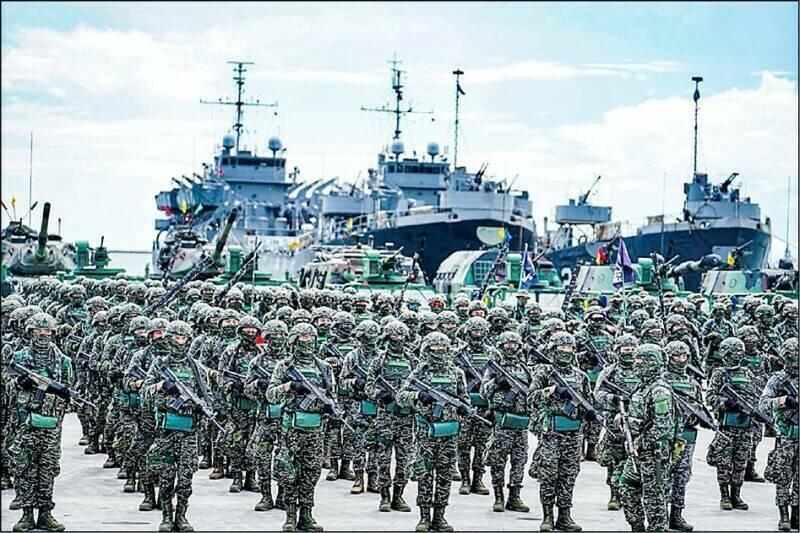The Cabinet plans to spend next year NT$949.5 billion (US$31.27 billion) on defense, amounting to 3.32 percent of GDP, the Directorate-General of Budget, Accounting and Statistics (DGBAS) said today, which would cross a threshold of 3 percent for the first time since 2009.
The move comes as China has ramped up military and political pressure over the past five years.
Taiwan also faces calls from Washington to spend more on its own defense, mirroring pressure from the US on Europe.

Photo: Taipei Times
This month, President William Lai (賴清德) said he wanted to boost defense spending to more than 3 percent of GDP next year.
The budget includes funding for the coast guard, veterans and special projects, the agency added.
It did not say what that meant in terms of a percentage increase over this year's defense spending.
Taiwan was including spending for the coast guard in its total defense budget for the first time, two senior officials briefed on the matter told Reuters, speaking on condition of anonymity.
"They are standing on the frontline," said one, referring to the coast guard, which engages in regular standoffs with China's coast guard and would, in time of war, be pressed into the navy's efforts to defend Taiwan.
The Cabinet is holding a news conference to announce budget details.
Taiwan's government has made military modernization a key policy platform and has repeatedly pledged to spend more on its defenses given the rising threat from China, including developing made-in-Taiwan submarines.
China's air force flies almost daily missions into the skies near Taiwan, and holds periodic war games, the last in April.
China is also rapidly modernizing its armed forces, with new aircraft carriers, stealth fighter jets and missiles.
In March, China unveiled a rise of 7.2 percent in this year's defense spending, to 1.78 trillion yuan (US$248.17 billion), outpacing its economic growth target for this year of about 5 percent.

The Central Weather Administration (CWA) today issued a sea warning for Typhoon Fung-wong effective from 5:30pm, while local governments canceled school and work for tomorrow. A land warning is expected to be issued tomorrow morning before it is expected to make landfall on Wednesday, the agency said. Taoyuan, and well as Yilan, Hualien and Penghu counties canceled work and school for tomorrow, as well as mountainous district of Taipei and New Taipei City. For updated information on closures, please visit the Directorate-General of Personnel Administration Web site. As of 5pm today, Fung-wong was about 490km south-southwest of Oluanpi (鵝鑾鼻), Taiwan's southernmost point.

UNILATERAL MOVES: Officials have raised concerns that Beijing could try to exert economic control over Kinmen in a key development plan next year The Civil Aviation Administration (CAA) yesterday said that China has so far failed to provide any information about a new airport expected to open next year that is less than 10km from a Taiwanese airport, raising flight safety concerns. Xiamen Xiangan International Airport is only about 3km at its closest point from the islands in Kinmen County — the scene of on-off fighting during the Cold War — and construction work can be seen and heard clearly from the Taiwan side. In a written statement sent to Reuters, the CAA said that airports close to each other need detailed advanced

Tropical Storm Fung-Wong would likely strengthen into a typhoon later today as it continues moving westward across the Pacific before heading in Taiwan’s direction next week, the Central Weather Administration (CWA) said. As of 8am, Fung-Wong was about 2,190km east-southeast of Cape Oluanpi (鵝鑾鼻), Taiwan’s southernmost point, moving westward at 25kph and possibly accelerating to 31kph, CWA data showed. The tropical storm is currently over waters east of the Philippines and still far from Taiwan, CWA forecaster Tseng Chao-cheng (曾昭誠) said, adding that it could likely strengthen into a typhoon later in the day. It is forecast to reach the South China Sea

Almost a quarter of volunteer soldiers who signed up from 2021 to last year have sought early discharge, the Legislative Yuan’s Budget Center said in a report. The report said that 12,884 of 52,674 people who volunteered in the period had sought an early exit from the military, returning NT$895.96 million (US$28.86 million) to the government. In 2021, there was a 105.34 percent rise in the volunteer recruitment rate, but the number has steadily declined since then, missing recruitment targets, the Chinese-language United Daily News said, citing the report. In 2021, only 521 volunteers dropped out of the military, the report said, citing